Invasion Force Gets Off the Ground : 20 Hovercraft Train Along Coast of Camp Pendleton
- Share via
CAMP PENDLETON — The noise was deafening, the dust clouds immense. It could have been Somalia or the Persian Gulf, but it was here, mere feet from a rocky cliff, with the waters of the Pacific lapping in the distance.
*
On Tuesday, Navy Capt. Hank Howe labeled it “Hovercraft Central.”
This was no ordinary exercise, Howe said. These 20 Hovercraft, or LCAC (Landing Craft, Air Cushion) were the largest number to fly in formation at one time anywhere in the world. This was practice, he said, but “important practice” for a potential military crisis similar to those in Somalia and the Persian Gulf.
The 7-year-old Hovercraft--35 of them based at Camp Pendleton, with 35 more in Little Creek, Va.--were deployed in both Somalia and the Persian Gulf and, in Howe’s view, played indispensable roles in both conflicts.
Their primary contribution: giving the United States an “over the horizon” invasion force in which each Hovercraft can deliver 75 tons of soldiers and equipment from a maximum of 200 miles from shore. The craft’s water speed is 35 knots and they can go 25 m.p.h. over terrain.
“In a nutshell,” Howe said, “they expand the number of beaches we can hit, allowing us to go farther and deeper inland from the cushion of an over-the-horizon offshore location.”
Each vessel is 47 feet wide and 87 feet long, a flat, rectangular, amphibious assault vehicle that, in Howe’s words, is akin to flying “a bar of soap.” The craft is powered by six turbine engines that, on Tuesday, stretched the decibel level to an eardrum’s limit.
Crew members wore earplugs, and those with contact lenses strapped on goggles to fight off the dust clouds created by an armada of LCAC from ACU-5, otherwise known as Assault Craft Unit headquarters at Camp Pendleton.
“We love acronyms,” Howe said.
But he also loves Hovercraft, which arms experts say can cover 70% of the world’s coastal areas, as compared to the 17% that its predecessors could handle.
The units cost $22 million each and are manufactured by two New Orleans firms. While at sea, they’re stored, not on aircraft carriers, but on amphibious vessels that carry what is known as a “wet well.”
Navy officials say no Hovercraft have been damaged so far, but then none has encountered open conflict, even during Operation Desert Storm. The U.S. uses them primarily to move massive amounts of military equipment from sea to land, although each can carry 23 combat-ready Marines.
“With the weapons capabilities other countries have, the over-the-horizon factor is the strongest attribute,” Howe said. “By launching 35 miles offshore (the usual deployment distance), that’s an enormous arc for anyone to defend against.”
No other country has a Hovercraft quite like the U.S.-made LCAC, Howe said. However, Japan is about to purchase two from the United States, with delivery scheduled for 1997. North Korea and Russia have Hovercraft, but in his words, they “don’t compare.”
Some of the Camp Pendleton-based LCACs are currently deployed, with four due to return Thursday. Two are in Sasebo, Japan, near the North Korean coast; four are in the Indian Ocean and one is in Guam.
Navy Lt. Scott Davies, 28, is a veteran of Hovercraft deployments, having used them in Somalia from October, 1993, to February.
“We went to six different landing sites,” Davies said. “Most displacement vessels were incapable of landing because of low tides and sandbars. The LCAC were able to land in Somalia, cross through sand--it’s extremely soft there--and move up to a hard, packed road within minutes.”
The sensation of riding one, Davies said, is akin to flying, “especially when you’re over land, since no part of the craft touches ground while in operation. The bottom of the skirt is two to three inches off the ground, while the bottom of the hull is four feet off the ground. The skirt entraps the air, which gives you the lift.”
More to Read
Sign up for Essential California
The most important California stories and recommendations in your inbox every morning.
You may occasionally receive promotional content from the Los Angeles Times.













